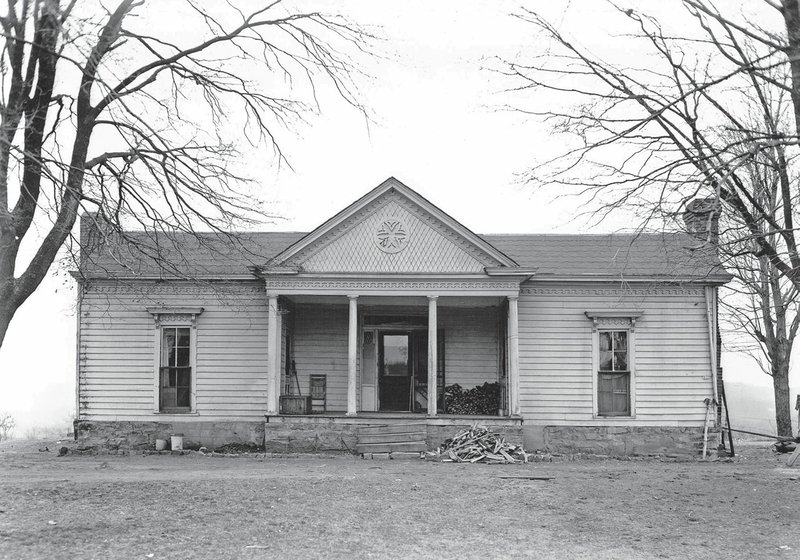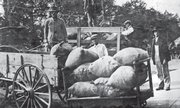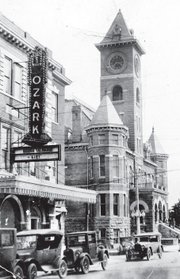On a late afternoon in 1819, a herd of buffalo grazed on thickets of grass sweeping across a broad, open expanse of prairie, hemmed in by mountains on the south side of what is now Fayetteville," writes Charles Y. Alison in this year's A Brief History of Fayetteville, Arkansas (The History Press).
Frank Pierce, a hunter and trapper, sat in a valley bordered on the eastern edge by a creek and its confluence with the West Fork of the White River, which he had followed upstream, looking for game, Alison continued. Earlier that year, Congress had created the Arkansas Territory, splitting from the Missouri Territory to the north.
A Brief History
of Fayettville,
Arkansas
Author: Charles Y. Alison
Publisher: The History Press
Year: 2017
Cost: $21.99
Pierce spotted the herd of buffalo, but as he maneuvered to a spot from which to take aim, he also spotted a band of Indians.
"He lowered his gun without firing, dropped under the bank and retired for the night under the friendly shelter of a large elm," Alison writes.
The Indians likely were Wazhazhes, of the Osage Nation, who spent their autumns and winters in the Missouri River Valley, Alison posits. Or they could have been Quapaw or Caddo, who ranged into what became Northwest Arkansas.
In 1828, the year the region was open to white settlement, Pierce returned to that valley and creek -- now known as Town Branch. He settled near the spot "where, nine years, earlier, he had spent the night bivouacked in hiding from the band of Native Americans," Alison writes.
Seven families had staked homesteads ahead of Pierce, including Mary (Rowell) and James McGarrah -- who were the first, Alison records. Settlers moved in quickly, and the state designated the community as the county seat of Washington County.
The community was initially know as "Washington County Court House," but with another town in southern Arkansas already designated as "Washington," the U.S. postmaster asked that the name be changed, Alison shares. The town's three commissioners chose the name "Fayetteville" because two of them came from Fayetteville, Tenn.
Alison's history continues through the Civil War, the founding of the University of Arkansas and the first modern shopping center at Evelyn Hills to the campaign to "Keep Fayetteville Funky."
HOME
Alison came to Fayetteville at age 7, when his family moved from Kansas in 1965. He recalled childhood homes on Rush Drive and Crest Drive fondly. "We were allowed a long leash to run around in the nearby woods," he said.
Alison graduated from Fayetteville High School and then the University of Arkansas, but he felt he wanted to see more of the United States, so he rode his bicycle along the West Coast.
"I'd gone skiing in Colorado, but not really been out west," he said. "I'd thought the U.S. was really great, and I wanted to see more of it.
"All the time, I was looking for a place to root my adult life," Alison continued. "On a bicycle, you really get to see and look at a town."
However, when Alison got to San Diego, he turned and went back to Fayetteville.
"I saw Fayetteville had its own wonderfulness," he said, which he finds in Fayetteville's ability to reinvent itself. "The city grows, and it keeps changing to meet that growth."
GENERATIONS
Alison credited his mother with his love for history.
"My mom grew up in Liberty, Kan.," he shared. The town had a square very much like Fayetteville's with the county courthouse in the center. In Fayetteville, the Post Office occupied that space.
"Four or five generations were the family roots in the town," Alison said. "I heard lots of stories relayed by my uncles that I could relate to."
The studies for his master's degree in journalism from the university required half of the coursework to be taken in another area. Alison chose history.
"I credit the history faculty for teaching me how to look at things and the journalism faculty for how to weave it together," he said.
Alison worked with Ellen Compton to compile a pictorial history of Fayetteville, released in 2011, for the Images of America series by Arcadia Publishing. That experience led him to build a website dedicated to the history of Fayetteville, through which The History Press found him to write this book.
Alison is a member of the Washington County Historical Society's board of directors and editor of the group's quarterly historical journal, Flashback.
He is the executive director of the Office of University Relations at the University of Arkansas, where he edits the alumni magazine and the university's catalog of studies, among other projects.
FAVORITES
Alison's favorite chapter of Fayetteville history is the 1850s, he said.
"Fayetteville was really just booming," he said.
The Fayetteville Female Seminary was established in 1839, and a student wrote the first music published by an Arkansan, Alison listed. Then Arkansas College was founded in 1850 as the Fayetteville Male Academy.
The merchant class almost doubled. The Butterfield Overland Mail stagecoach, railroads and telegraph came to town. "These increased the sense of connection to the east, and a string of railroad stations connected us to the West Coast.
"They changed psychologically the way people lived here, as well as others along the route -- not just Fayetteville, but the whole South," Alison said. "How they can throw it all away in the 1860s [with the Civil War] still stumps me."
Alison also expressed surprise at how easily Fayetteville weathered the Great Depression of the 1930s. "We suffered, but we are good at bouncing back," he said. "There were no bank closures in the first five years of the Depression -- although two merged."
Many stories Alison researched are not included in the book, "but it is a 'brief' history," Alison said with a laugh.
He said he would like to further research Fayetteville's role in music during the 1950s to 1980s, as well as writers in the area and the influence of the University of Arkansas' creative writing program.
"And food," Alison said. "Fayetteville is a place that loves its cafes and restaurants. There are jillions."
On a trip to Omaha, Neb., with a friend several years ago to watch the Razorback baseball team play in the College World Series, to stay awake on the road, the pair set out to create a list of 50 restaurants that no longer existed in Fayetteville.
"It surprised me that we had more than 50 before we hit Joplin," Alison said.
"A lot has been written about the 19th century in Fayetteville, and it barely goes into the 20th," Alison concluded. "It was wide open, and I tried to make a stab at it. So much more could be researched and written about. I hope other historians up and coming can include some of the things I missed."
NAN Our Town on 06/29/2017


